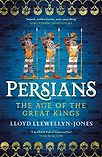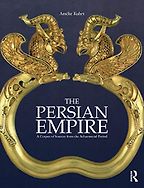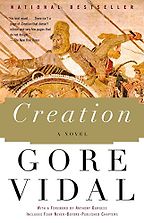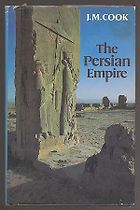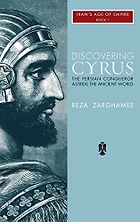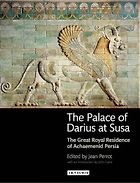Before we get to the books you’re recommending, can you give us a brief overview of the Achaemenid Persian Empire’s period of existence, its geographical extent and what lay behind its power?
It was the first of the three great Persian empires of antiquity. The conventional dating for it is 559 to 330 BCE, that is from the founding of the empire under Cyrus the Great, coming out of central Iran and quickly establishing a foothold in modern-day Turkey and across the Middle East. And it runs then until the reign of Darius III, who was defeated by Alexander of Macedon. In its time, it was the biggest empire the world had ever seen, based in central Iran in ancient Fars Province. It stretched right the way out to the deserts of Libya in North Africa and down the Nile into Ethiopia. To the north, it extended to southern Russia and, to the east, it went right the way over to modern Pakistan. So, it was an empire of colossal size and really hung together because of its remarkable administration. Its communications processes were next to none. It had great road systems and its satraps—its governors—were stationed across the whole empire, bringing a kind of unity and harmony to it.
Empire building obviously involves conquest. The Achaemenid army was very strong. But, having conquered different regions, the Persians adopted a very different format for running their empire than, say, the British or the Romans. The Romans and the British stamped their imperial authority on local areas. You can identify a Roman site whether you’re in North Africa or in Italy. The buildings are the same. The Persians never did that. They adopted a more laisser-faire attitude and, as long as the tribute and the taxes came in, then they did not interfere with local systems. In fact, they encouraged the Persian satraps to work with local dynasts to keep the preexisting systems going. That’s not to say there weren’t rebellions and there weren’t uprisings. Egypt was always a difficult place to control but, by and large, it was a remarkably peaceful and workable empire.
Are there particular things we learn from studying the Achaemenid Empire, or particularly important reasons for studying it?
I think so. What’s going on in universities and within scholarship at the moment, this idea of decolonizing the curriculum, is very important. For far too long we’ve been invested in this myth of Eurocentricity and it all relates to the Persian Empire. The great narrative that we have—of the birth of freedom over tyranny in ancient Greece, with battles like Marathon, Thermopylae and Salamis—really has to be tempered. We have to look at the Persian version to see that there was a very different rhetoric going on and that the Persian Empire itself was not a thing of oppression, depravity and decadence. Those are the buzzwords that authors for millennia have used—stressing the contrast between the free West and the corrupt East. That is still going on in our newspapers every day. Look at social media; that image is still there.
We have to right that wrong. We have to show that the Persians and other easterners were sophisticated and cultured, embracing, thoughtful and scientific—all the things that a harmful brand of Orientalism says that they’re not.
Tell us a bit about the book you’ve just finished writing.
It’s my first ever commercial book. The publishers wanted something on the Achaemenid Empire. So it’s simply called The Persians. What I’ve tried to do in it is to put upfront what I believe is the most important way of looking at Persia and that is through Persian sources. When Greek sources are used, I’ve employed those that have more kudos on Persia than others. For instance, I’m quite down on Herodotus. I don’t think he’s a very reliable source for things like court society, although he’s quite good on the bigger picture of Persia. Ctesias of Cnidus, I think, is a far more reliable source on court life and, importantly, at conveying genuine Persian stories. I’m using Greek sources that I think have more flesh on their bones than others, but I’m using as many Persian sources as I can for what I call ‘the Persian version’ of the story.
“It was an empire of colossal size and really hung together because of its remarkable administration”
I really hope it’s going to be a book that will stimulate the popular imagination, but also have a different take, which is to stop Eurocentrising ancient history. We’ve done enough of that. I’ve managed to write the Battle of Marathon in a sentence and a half, for instance. It was of very little consequence to the Persians. Xerxes’s invasion of Athens gets a chapter because I think the Persians were more aware of that; they historicized it themselves. The Persians is a very fresh look at Persia and I really hope it works. I’ve got a feeling it will go down quite well, certainly on the back of BBC 4’s “Art of Persia.” It had an amazing takeup, so there’s clearly an appetite for Persian things out there. It’s one of my missions to get Persia into mainstream, popular discourse because it’s a fascinating area.
When will the book be published?
It’s scheduled for 2022, but it might come out earlier because I’ve nearly finished it.
Let’s move on to the books you’re recommending: first up is The Persian Empire by J. M. Cook. Tell us why you’ve chosen this one.
I like it a lot. It was published in 1980 and it kind of disappeared underneath what was happening in academia at the time. In 1978 Edward Said published Orientalism and this made a major contribution to the way in which we began to look at Persian history. In 1980, at the University of Groningen in the Netherlands, they started a seminar series called the Achaemenid History Workshop and its main focus was to look at whether the Persian Empire really was this empire of decadence. Was it in decline at the time of Alexander? Did Alexander just strike the death blow to this imperial system that was in sharp decline anyway? (The answer was ‘no’, by the way).
All of that came out of Said’s conception of how the West had seen the East, and it was just a terrible accident of fate that Cook published his book on the eve of that revolution. The book received enormous criticism from the members of this Achaemenid Workshop in particular, who became the giants of Persian studies, like Heleen Scancisi-Weerdenburg, Pierre Briant and others. They saw it as the last vestige of an orientalist tract. John Cook, who was trained as a classicist, was in his 80s when he wrote the book. He used phrases like ‘in the Orient we can see’ or ‘the Oriental mindset’ and so forth, but never in a detrimental or patronising way. But they pounced on him as a scapegoat, a sacrificial victim, for this new kind of thinking about the Persian Empire.
I often wonder if they really read Cook’s book properly, because what I see in his work is a very balanced and careful use of the sources. Cook trained as a classicist and knows his classical sources really well but, at the same time, throughout the book he is doing things that no other ancient historian was doing at the time. He was using cuneiform evidence. He was looking at Persian art and Persian architecture. He had travelled to Iran. It is quite clear that he loved the place. This is not a derogatory, orientalist diatribe of the kind that the critics immediately took it to be. It lost its kudos almost entirely. I don’t know how John Cook took it. I’ve never seen any rebuttal. I think he died shortly afterwards, sadly.
“It’s one of my missions to get Persia into mainstream, popular discourse because it’s a fascinating area”
But when you look at it today, I think his Persian Empire still stands as a very competent text, anticipating a lot of the questions that the Achaemenid Workshop itself was set up to answer and looked into over the next three decades. I go back to it time and time again because it’s reliable, it’s factual and you see a really good ancient historian grappling with questions that are still being grappled with today.
So, if there’s a book I would like to reintroduce it’s this one. I would love to see it republished and remarketed to get the kudos I think it deserves. I give my students sections of it to read because it’s a very straight, clear narrative history, which is what I like. It’s very readable and beautifully written, as well. He was in his prime in the 1950s and he has the beautiful rhetorical style of that era. It’s an elegant read.
I also feel close to it because Cook ended his career at Edinburgh University, which is where I started mine. In fact, I reintroduced Persian studies to Edinburgh University and I was always aware that I was in the shadow of Cook. So, I’ve always kind of championed him. It’s a book that means a lot to me, but a book that is far cleverer, far more pertinent and far more aware of the genuine Persian sources than it’s been credited with.
Let’s move on to Discovering Cyrus: a Persian Conqueror Astride the Ancient World by Reza Zaghamee.
This is a mammoth book, around 900 pages. I really like it because it’s full of the zest and enthusiasm of this young Iranian scholar looking at his own history. This is really important for me because I think that, in Iran today, ancient history is very political, as you can imagine. What the Iranians do with their pre-Islamic past is a hot potato. Therefore, within Iran itself, there is very little history being written by Iranian scholars. But the Iranian diaspora is producing scholars and I think that’s important. It goes back to my point about the Westernization of Persian history. Why are we Europeans and Americans writing this? We should be hearing Iranian voices. Zaghamee’s book is enthusiastic and it flows and it’s vibrant and lively. And yet, at the same time, he’s a very careful scholar. He goes into real detail on every aspect of what he could put together as a biography of Cyrus.
Writing a biography of any Achaemenid monarch is almost impossible because most of the time we’re dealing with Greco-Roman sources. What he does with those sources is he takes them apart and tries to look for the Persian version—or the Near Eastern version—that sits behind them. The other thing he does, which I think is really interesting, is that he’s very aware of the reception of Cyrus within Persian culture across the millennium. So, where you might find stories of Cyrus the Great in embryo in tales from, for instance, the Shahnameh—the Epic of Kings—a medieval treatment of Persian history, he looks at those strands that maybe we as westerners wouldn’t immediately see, but are very much alive in the Iranian tradition today.
It’s a big book and it’s not immediately useful for teaching, but it’s actually one that readers could sit with over a couple of months and really enjoy. It’s finely written. And it’s packed full of fact and packed full of interesting ideas on a slant, which I like very much indeed.
You’ve mentioned that the historian has to rely more than he or she would like on Greek sources when writing about ancient Persia. Was there a written culture that has simply been lost or did the Achaemenid Empire not produce written works of literature or history?
We have royal inscriptions from Persia written in the Old Persian language, in cuneiform, but these, by and large, are very ahistorical. Really, they are boasts by Persian kings of the extent of the Empire and what they’ve done, plus lists of imperial titles.
We only have one narrative account. That is the rather bogus account of Darius the Great’s accession to power. But there was no conception of writing down history as in the Greek form, like Herodotus. That’s not to say that the Persians didn’t have a concept of history. They just remembered it differently. And I think the way in which they used, or activated their history, was through poetry, through song, what Parry and Lord identified as ‘the oral tradition’. So, I think that, if we were to look for a Persian history, it would be more akin to a Homeric epic, than an ‘inquiry’ in the Herodotean style. That was something that really didn’t appeal to Near Easterners generally. And, of course, the Iranians, with their origins in Indo-European/ Eurasian society employed the same historical tradition as Mongols or Turks—essentially song and poetry in oral transmission is how they would have remembered. That’s a huge barrier for us. So, very often we have to rely on the Greek sources to give us narrative.
What we are able to do now, of course, is to punctuate those narratives with genuine Persian things and it’s a concept that people were thinking about before the Achaemenid History Workshop started. In the 1940s, for instance, Robert Graves, the brilliant classicist, wrote a fantastic poem called “The Persian Version” in which he asks whether you can really imagine that the Greek story of the Battle of Marathon was how the Persians thought of it. He points out that it wasn’t something that was played out on stages in tragedies for them. It was just a skirmish and nothing more. That really encouraged me to take that stance in my book, as well.
So, there are big source problems, but not insurmountable ones.
Cyrus was the founder of the Achaemenid Empire. Where did he spring from and what was it that drove him to establish the Empire? How did this huge political power suddenly emerge in the Middle East?
It is quite remarkable. I think he truly deserves the title ‘the Great’. He must have been a man of genius. He came from an area in southwest Iran which today is Fars Province, around the area of Shiraz, towards the Zagros Mountains. He was known there as the King of Anshan—Anshan was the name of this ancient province. At the time of his birth, around about 600 BCE, the tribes in the north of Iran, the Medes, were becoming increasingly aggressive towards their southern Persian neighbours and they almost set up a protectorate in Persia, governed by high-ranking Medes. So, there was a great deal of hostility in the south, in the tribes of the Persians, with the Medes. It was Cyrus who first gathered the different confederacies of the Persians—the Persians were a very tribal society. They were an equestrian society. In my book I call the leaders of these tribes not ‘chiefs’, but ‘khans’, which is Eurasian and, I think, the right word for them; I want to get the reader to think of the Persians as part of the cultural world of Eurasia. Cyrus united these tribes under his banner and marched north with them. He defeated the khanate of the Medes. And with that, Cyrus inherited the nomadic empire of the Medes, which stretched around the Caspian Sea and into northern Turkey as well: so large swaths of land. From there he was unstoppable. He marched over the whole of Anatolia to the coast, put to death king Croesus and captured Sardis, the wealthiest city in the known world.
Get the weekly Five Books newsletter
Then, marching back to Persia, he decided to have a go at Babylon which was the greatest metropolis in the world at the time, but in a lot of trouble under its later kings, who had really let the city go. He conquered Babylon very easily. In fact, Babylon opened its doors to Cyrus, having been forewarned of the damage that could be done—he completely destroyed the city of Opis, about 50 miles north of Babylon. But what’s interesting about Cyrus is that, very craftily, in a very modern way, he used propaganda to endorse the conquest of Babylon, calling it a liberation from the oppression of its very weak rulers. And he used the Babylonian priests to write this document, which we call ‘the Cyrus Cylinder’, now in the British Museum. It put forward this idea that he had been blessed by the gods of Babylon, that the god Marduk had chosen Cyrus as his champion. Cyrus was very good at spin!
The wording in the Cyrus Cylinder is found in the prophecies of Isaiah, in the Hebrew Bible, where Cyrus is the champion of YHWH, the Jewish God and gone down in history for liberating the Jews from their Babylonian bondage. Cyrus played very carefully to different audiences and I think that propaganda is one of the real successes of the Persian Empire. It was built on this idea of liberation, even though it really wasn’t. I always think of George Bush, when he first went into Iraq in the first Gulf War. He called it ‘Operation Iraqi Freedom’. I think we can call Cyrus’s Babylon campaign ‘Operation Babylonian Freedom’ in the same kind of way.
What was the root of Cyrus’s strength? Did he develop particularly novel military tactics, or technology, or was there a particular commodity behind the empire’s economic strength?
He didn’t really have new tactics, or introduce new weaponry. What he did have was an incredible cavalry. The Persians had always been amazing horsemen. On Darius the Great’s tomb inscription it says: “I am as great a bowman as a spearman; I’m as great a spearman as a horseman; I am a great horseman.” It’s those three things that set the Persians apart. You might have heard of the so-called ‘Parthian shot’, for instance, where a rider could turn at 90 degrees and fire arrows behind him so he could circle his enemies. It was the tactics of the cavalry more than anything else that won the Persians their victories.
Your next book is The Persian Empire: A Corpus of Sources from the Achaemenid Period by Amélie Kuhrt.
This is another great doorstop of a book, running to over 1,000 pages. It was originally published in two volumes in hardback and went into paperback a few years later. It is the most invaluable teaching tool for me. I teach several courses on Ancient Persia and this is an amazing compendium of all types of sources on the Persian Empire. It utilises old Persian inscriptions, Babylonian texts, Aramaic texts, Hebrew texts, Greek and Latin texts. They’re all there in translation and with Kuhrt’s very useful, very competent and very intelligent commentaries as well. She’s one of the great names in ancient Near Eastern studies and I admire her very much. Before The Persian Empire, she’d already published a two-volume history of the ancient Near East, which is a mammoth undertaking—from 3000 BCE, right until 300 BCE. She knows her stuff and what she was able to do in the sourcebook is bring together the richness and variety of the Persian sources.
In some respects, The Persian Empire is still just the tip of the iceberg, because what she’s not able to do in that source book is to bring together all of the visual evidence, although there’s some visual material there. The visual stuff, of course, is even richer than the textual stuff. She’s not really able to do much of the archaeology, or much of the iconography, but it’s a starting point. She does try. The texts themselves are all there, with modern translations and up-to-date commentaries. It’s the most useful tool for anybody wishing to go further into the source materials for the study of Persia.
Let’s move on to The Palace of Darius at Susa: The Great Royal Residence of Achaemenid Persia by Jean Perrot.
This is a very beautiful book. It’s a large-scale book, translated from the original French. It was funded by the Institute of Iranian Studies. How they managed to fund it, I don’t know, because it sold originally for £30 and it is a rich, coffee-table, picture-heavy, colourful book.
First of all, it has the visual appeal, which I love. But what is really magnificent about it is that it goes into detail about the archaeology, the art and architecture of just one site, the royal city of Susa. Susa was one of the main palatial centres of the Achaemenid Empire and it’s also one of the oldest cities on Earth, going back to at least 4000 BCE. This book offers a wonderful description, first of all, of the archaeological site and the layers and layers of civilization there. Then the author focuses on the palace itself. We get to see the layout of the palace, the wonderful Apadana, or throne hall, and the council and harem. Then there is the wonderful art that has survived from Susa, most particularly the colourful brick compositions showing immortals or royal guards in their costumes and magnificent beasts—bulls, lions and so forth.
“There are big source problems, but not insurmountable ones”
It’s a magnificent visual compendium to the Persian Empire. It really starts you off thinking about the Persian world visually and, for me at the moment, it’s an important book because the biblical book of Esther is set in the city of Susa. The book I’m going to write next is a commentary on the book of Esther, but looking at Esther from a Persian perspective. There’s great scholarship on Esther from the biblical studies field, but very few of them have any real understanding of Persian history or Persian culture. The book of Esther itself is a product of the 4th century BCE. It was written by somebody who knew a lot about the workings of the Persian court. My commentary will, essentially, bring in all the Persian material, just to show how au fait the author of Esther is with that.
But I want to go a step further and do what’s called an ‘iconographic exegesis’. An idea that’s become really big in Germany and Switzerland over the last decade is that literature only takes us so far, but that there’s a wonderful world of iconography out there as well. A biblical scholar called Othmar Keel in the 1970s and 80s did this incredible commentary on the book of Psalms and the Song of Songs using the iconography of the ancient near East. I think Esther, which is a very visual book, lends itself to the same kind of process, of trying to look at it through as many visual sources as possible. For instance, when I’m talking about the beauty of Esther, described in Chapter 2 of the book, I’ll be drawing on images of Persian women and that kind of thing.
This book really gives me a wonderful visualization, a way in to thinking about the colourful world of the Persian court in the 5th and 4th centuries BCE.
And which Darius built Susa?
It was originally the work of Darius I, that’s Darius the Great. He was probably born in Susa and from that area. We know that his mother’s name was Irdabama and that’s definitely an Elamite or Susa name. The probability that he was born there is really emphasized by the fact that he glorifies the city. He built up these wonderful palaces and made a big play of building the city. We have one beautiful inscription from Susa dating to Darius’s reign, in which he talks about the building of the palace itself and that it was a labour of love. He talks about commissioning different people from different parts of the Empire to come and work on the palace: that people from Egypt brought gold and did the gold work and the ivory work; that the Babylonians were renowned for their bricks and they came and did the brick building; that the Assyrians transported the timber from Lebanon. There’s all this kind of rhetoric.
He’s putting out this idea that the whole of the Empire is for his use. And he uses the wealth of the Empire to build a superstructure at Susa for him, as a monument to the belief that the Empire works in harmony and is better together, as it were.
You mentioned that modern Iran has a complicated relationship with its pre-Islamic past. Is it easy to do archaeology in Iran?
For the last year 40 years the British really haven’t had much of a look-in in Iran as far as archaeology is concerned. I’m the director of the ancient Iran project for the British Institute of Persian Studies (BIPS) and, while we often get funding inquiries from scholars wanting to work in Iran, very, very few of them ever get visas or the permissions to dig. Other countries are far more successful. At the moment—for instance at Persepolis—the Italians are working with Iranian archaeologists at that amazing site.
Five Books interviews are expensive to produce. If you're enjoying this interview, please support us by donating a small amount.
A lot of archaeological work is still being done within Iran, but not much by the British and Americans. It’s a great shame, but it’s a product of the politics of the day.
Finally we have Creation by Gore Vidal, which is a novel. Tell us why you’ve chosen it.
It’s set around about 450 BCE. It tells the story of a man, a courtier in Persia, a grandson of the prophet Zoroaster, who is the best friend of Xerxes. Gore Vidal was one of the great historical novelists. His Julian is a masterpiece in its evocation of antiquity. What I found with Creation was that the court of Persia is brought to life with such vivacity and such colour, but with such feasibility, as well. Vidal has clearly read the historical sources. He must have looked at the art and architecture.
The story is crafted so carefully. The realia, the indicia of daily life, is echoed so well. But the bigger questions, the big what-ifs of Persian history, are handled beautifully too. He’s also aware of things we talked about earlier, that the Persians didn’t craft their history in ways that we do in the West. He indulges in that, he delights in that, of storytelling within stories. It’s a really fantastic book in its evocation of Persian life.
The hero travels to India and to China as well, which is very feasible. We know that the Iranians had very strong links to India in this period and it’s also very feasible that they had contacts, via middlemen, with China. It’s a sweeping epic story. The hero not only knows Darius and Xerxes, but also gets to meet the Buddha and Confucius. It’s a philosophical adventure story, if you like.
Were the Buddha and Confucius contemporaries of Xerxes?
Very feasibly. The Buddha (Siddhārtha Gautama) lived in India sometime in the 5th to 4th century BCE; Confucius was absolutely a contemporary of the Achaemenid kings.
And is the hero an identifiable historical figure? Or is he an invention of Gore Vidal’s around whom real historical events occur?
Vidal has this interesting story, which is the warp, and then the weft of it is this really fascinating take he has on the fact that these great religious thoughts were happening at the same time across the Middle East and the Far East. So Zoroastrianism, Buddhism and Confucianism were all flourishing, or budding I should say, at the same time. So he’s pulling together this idea that the ancient world was very interconnected, not just through trade routes, or through warfare, but also in forms of thought and theology. It is a little ahistorical, since Zoroaster was probably circulating his teachings around about 1000 BCE, not 450 BCE—that’s just a little bit of a nudge he gives to ahistoricicity. But otherwise it is this wonderful adventure story with a kind of theological mesh that’s woven into it as well. It’s a very good read.
Five Books aims to keep its book recommendations and interviews up to date. If you are the interviewee and would like to update your choice of books (or even just what you say about them) please email us at [email protected]

